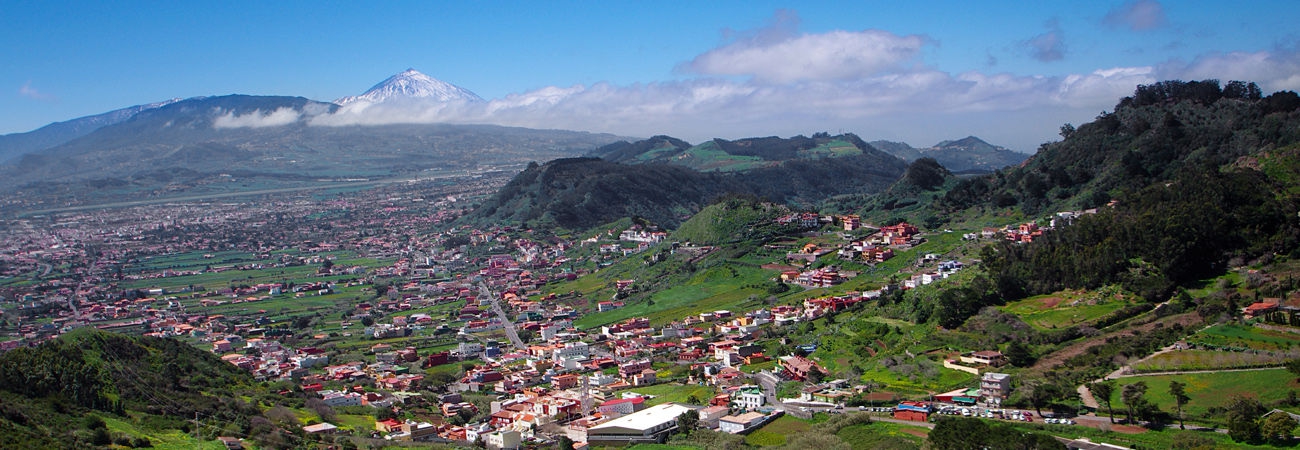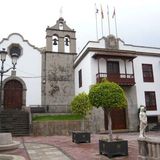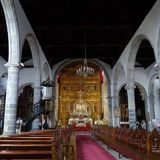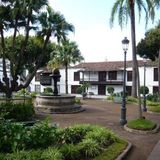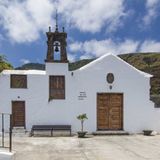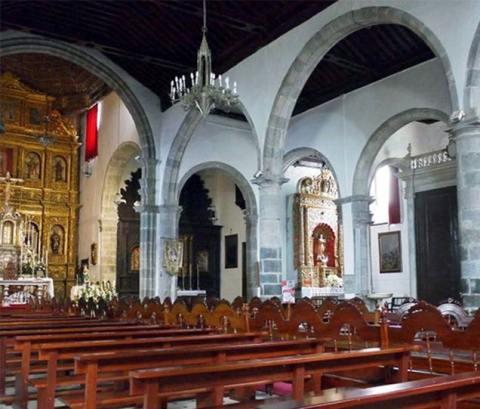Icod de los Vinos
The historical centre of Icod de los Vinos was declared a Property of Cultural Interest on 5th October 2004, in the category of “Historic Landmarks”.
Construction began in the late fifteenth century and continued according to the particular and social needs of the times.
The historical centre includes the following: The Mother Church of St. Mark, Plaza Andrés de Lorenzo Cáceres, Plaza de la Pila, Convent of St. Francis, the House Museum of Emeterio Gutiérrez Albelo, the Church of St. Augustine, the Cáceres Family Home, the Shrine of St. Anthony of Padua and the Shrine of Las Angustias (Our Lady of Anguish).
Historical Tour: click here
CHURCH OF SAN AGUSTIN and TOWN HALL
Visiting Times: During church services.
The Calle de San Agustín leads into Plaza de León Huerta, which is at the end of a stairway, with a balustrade and four Genoa statues representing the seasons. The Town Hall building overlooks the whole scene. It has a neo-Canarian facade and was built on the site of an old Augustine convent of San Sebastián, founded in the 16th century.
Some features remain of the original building, like the church of San Agustín (second half of the 16th century) which has managed to preserve the original arches and has a beautiful Mudejar moulded ceiling in the chapel of La Soledad. The neo-classical tabernacle of the chancel and the elegant pulpit are worth a visit.
The church also contains four interesting panels representing the Gospels and a statue of La Virgen de Gracia of the 17th century.
There are some 18th and 19th century buildings to be seen in Calle de San Sebastián, like the mansion of the Marquises de Santa Lucía, with a renaissance facade and baroque features, and the Fleytas house.
CHURCH OF SAN MARCOS
The Church of St. Mark and adjacent buildings were declared a Item of Cultural Interest on 16 May 2006, in the Monument category.
Address: Plaza de Lorenzo Cáceres
Tel.: (+34)922 810 695
Visiting Times: During church services.
Museum of Religious Art: from 9 a.m. to 1.30 p.m. and from 4 p.m. to 6.30 p.m.
The parish church of San Marcos Evangelista is located in Plaza de Lorenzo Cáceres, containing a rich heritage. Its origins are said to date back to the final years of the 15th century. In the 16th century, around 1570, it was rebuilt, turning it into a beautiful church with three naves. Rebuilding was directed by master stone mason Miguel Antúnez. Two chapels were added to the three main naves, separated by semicircular arches and pillars.
Mudejar style prevails in the building, although it does have outstanding features of other styles, like the renaissance doorway, the French Gothic style tower and the mainly Baroque reredos, choir and pulpits. The main reredos, Plateresque, is striking for its multiple niches. In one, and in the centre of the reredos, there is a figure of San Marcos Evangelista, a small Flemish-Gothic carving that, according to tradition, appeared on the coast of the "menceyato" - Guanche kingdom - of Icoden before the arrival of the Spaniards. It is therefore, the oldest figure in Tenerife.
The other niches hold fine sculptures:
The large painting of Las Animas (18th century work by José Tomás Pablo, from Puerto de la Cruz). Other paintings include a picture of Santa Ana and another of La Asunción.
The collection of precious metal work is on display in the museum. A special piece, both because of its size - 48 kilos and 2.4 m. high - and the elegance and precision of its work is the so called Filigree Cross. Made of solid silver in Havana between 1663 and 1665 by Jerónimo de Espellosa. It is classed as one of the best works of silver filigree in the world. The cross was paid for by Nicolás Estévez Borges, Bishop of Havana and a native of Icod.
PLAZA DE LA PILA and CHURCH OF SAN FRANCISCO
Address: near the Parish Church of San Marcos.
Going up the main stairway of Plaza de Los Cáceres, you get to Plaza de la Pila, or Plaza de la Constitución, surrounded by one of the most outstanding architectural and monumental sites in the Canary Islands, with 17th and 19th century buildings, including the Casa-Palacio of the Lorenzo-Cáceres family, a Mudejar combination with a neo-classical touch, that is currently undergoing restoration to become a museum and art centre. The elegant stone fountain is from the first half of the 18th century.
On one side of the square, going up Calle San Antonio, you come to the old hospital of Los Dolores, whose patio and upper balcony represent a fine architectural monument of the 17th century. The building is run by the sisters of the Orden del Buen Consejo.
Continuing along the same street, you come upon the Franciscan convent of El Espiritu Santo, with its sober lines, one of the best examples of 17th century Canary Island colonial architecture.
This includes the church of San Francisco, which conserves a Rococo Reredos crowned by a Calvary, with a carving of El Cristo de las Aguas, a figure that is widely worshipped. It was made in 1643 by Francisco Alonso de la Raya. It appears that the figure came to Icod during a long drought. The rains started as soon as the figure arrived.
Related to the convent, though forming a separate unit, there is the chapel of Nuestra Señora de los Dolores, considered one of the finest examples of 18th century Tenerife religious architecture.
Inside, it combines Mudejar style with Rococo decoration and Portuguese style in the painted ceiling of the presbytery.
Opposite the chapel, in Calle de San Francisco, is the House-Museum of poet Emeterio Gutiérrez Arvelo.
CHURCH OF LAS ANGUSTIAS
Address: C/ de Las Angustias
Descending from Parque del Drago, you come to the Church of Las Angustias, in the street of the same name. It is an 18th century church housing a figure of the Virgen de Las Angustias, one of the most representative works of Mexican Baroque (18th century), along with other works like El Cristo de la Columna, 18th century Seville School, and a San José by Fernando Estévez.
The many votive offerings include a stuffed crocodile, a gift from an emigrant of the time when the church was founded.







